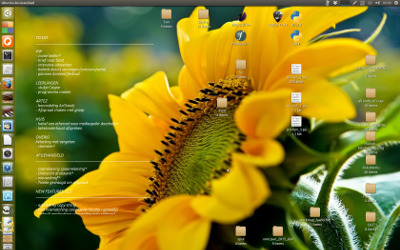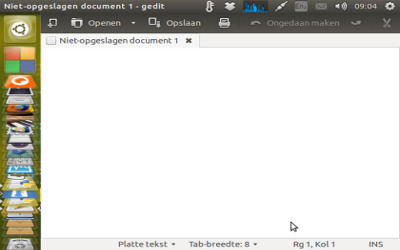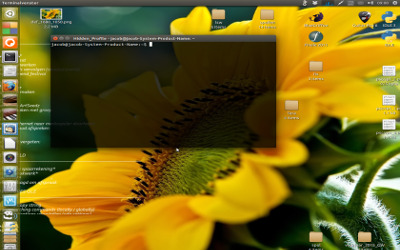问题描述
有些应用程序(主要基于Java)不遵循我在screen-settings中设置的global 2x scale。因此,在我的3200x1800px高DPI屏幕上,这些应用程序确实很小。
如何让这些应用程序以较小的屏幕分辨率运行?
最佳思路
一个主要的便利升级是使用后台脚本,自动设置每个应用程序的分辨率,同时您可以一次为不同(多个)应用程序设置不同的分辨率。
这正是下面的脚本所做的。
默认分辨率 1680x1050 的示例:

运行 gedit ,自动更改为 640x480 :

运行 gnome-terminal ,自动更改为 1280x1024 :

当应用程序关闭时,分辨率自动设置回1680x1050
如何使用
-
将下面的脚本复制到一个空文件中,保存为
set_resolution.py -
在脚本的头部,在行中设置默认分辨率:
#--- set the default resolution below default = "1680x1050" #--- -
在同一个目录(文件夹)中,创建一个文本文件,完全命名为:
procsdata.txt。在此文本文件中,设置所需的应用程序或进程,后跟一个空格,然后是所需的分辨率。每行一个应用程序或脚本,如下所示:gedit 640x480 gnome-terminal 1280x1024 java 1280x1024 -
通过以下命令运行脚本:
python3 /path/to/set_resolution.py
说明
该脚本使用 pgrep -f <process> ,它捕获所有匹配项,包括脚本。可能的缺点是在打开与进程同名的文件时可能会导致名称冲突。如果遇到类似问题,请更改:
matches.append([p, subprocess.check_output(["pgrep", "-f", p]).decode("utf-8")])
进入:
matches.append([p, subprocess.check_output(["pgrep", p]).decode("utf-8")])
剧本
#!/usr/bin/env python3
import subprocess
import os
import time
#--- set the default resolution below
default = "1680x1050"
#---
# read the datafile
curr_dir = os.path.dirname(os.path.abspath(__file__))
datafile = curr_dir+"/procsdata.txt"
procs_data = [l.split() for l in open(datafile).read().splitlines() if not l == "\n"]
procs = [pdata[0] for pdata in procs_data]
def check_matches():
# function to find possible running (listed) applications
matches = []
for p in procs:
try:
matches.append([p, subprocess.check_output(["pgrep", "-f", p]).decode("utf-8")])
except subprocess.CalledProcessError:
pass
match = matches[-1][0] if len(matches) != 0 else None
return match
matches1 = check_matches()
while True:
time.sleep(2)
matches2 = check_matches()
if matches2 == matches1:
pass
else:
if matches2 != None:
# a listed application started up since two seconds ago
resdata = [("x").join(item[1].split("x")) for item in \
procs_data if item[0] == matches2][0]
elif matches2 == None:
# none of the listed applications is running any more
resdata = default
subprocess.Popen(["xrandr", "-s", resdata])
matches1 = matches2
time.sleep(1)
Explanation
脚本启动时,它将读取您在其中定义了应用程序及其对应的所需屏幕分辨率的文件。
然后它会密切关注正在运行的进程(为每个应用程序运行 pgrep -f <process>)并在应用程序启动时设置分辨率。
当pgrep -f <process>不为任何列出的应用程序产生输出时,它将分辨率设置为”default”。
编辑:
“Dynamic” 版本(按要求)
虽然上述版本适用于多个列出的应用程序,但它一次只能为一个应用程序设置分辨率。
下面的版本可以处理具有不同(所需)分辨率的不同应用程序,同时运行。后台脚本将跟踪最前面的应用程序,并相应地设置分辨率。它也适用于 Alt + Tab 。
请注意,如果您在桌面应用程序和列出的应用程序之间进行大量切换,此行为可能会很烦人。频繁的分辨率切换可能太多了。
如何设置的差异
设置几乎相同,因为这个使用 wmctrl 和 xdotool :
sudo apt-get install wmctrl
sudo apt-get install xdotool
剧本
#!/usr/bin/env python3
import subprocess
import os
import sys
import time
#--- set default resolution below
resolution = "1680x1050"
#---
curr_dir = os.path.dirname(os.path.abspath(__file__))
datafile = curr_dir+"/procsdata.txt"
applist = [l.split() for l in open(datafile).read().splitlines()]
apps = [item[0] for item in applist]
def get(cmd):
try:
return subprocess.check_output(["/bin/bash", "-c", cmd]).decode("utf-8")
except subprocess.CalledProcessError:
pass
def get_pids():
# returns pids of listed applications; seems ok
runs = []
for item in apps:
pid = get("pgrep -f "+item)
if pid != None:
runs.append((item, pid.strip()))
return runs
def check_frontmost():
# returns data on the frontmost window; seems ok
frontmost = str(hex(int(get("xdotool getwindowfocus").strip())))
frontmost = frontmost[:2]+"0"+frontmost[2:]
try:
wlist = get("wmctrl -lpG").splitlines()
return [l for l in wlist if frontmost in l]
except subprocess.CalledProcessError:
pass
def front_pid():
# returns the frontmost pid, seems ok
return check_frontmost()[0].split()[2]
def matching():
# nakijken
running = get_pids(); frontmost = check_frontmost()
if all([frontmost != None, len(running) != 0]):
matches = [item[0] for item in running if item[1] == frontmost[0].split()[2]]
if len(matches) != 0:
return matches[0]
else:
pass
trigger1 = matching()
while True:
time.sleep(1)
trigger2 = matching()
if trigger2 != trigger1:
if trigger2 == None:
command = "xrandr -s "+resolution
else:
command = "xrandr -s "+[it[1] for it in applist if it[0] == trigger2][0]
subprocess.Popen(["/bin/bash", "-c", command])
print(trigger2, command)
trigger1 = trigger2
说明
-
虽然我现在已经运行了几个小时没有错误,但请彻底测试它。如果可能发生错误,请发表评论。
-
该脚本原样适用于单个监视器设置。
次佳思路
测试添加到您的 java 命令行: -Dsun.java2d.uiScale=2.0 ,或将其设置为您想要的比例因子。
